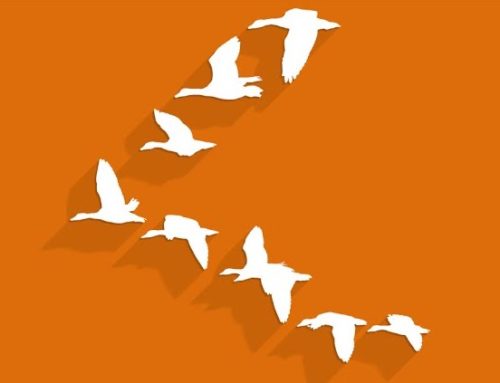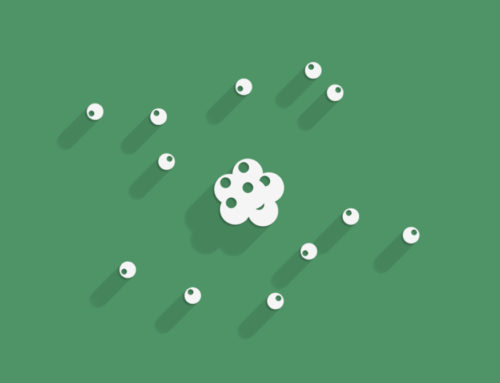Ecological Synergies
Two honey bees (Apis mellifera) foraging for nectar and pollen on a yellow sunflower. These synergistic interactions are of importance in the production of honey as well as being critical to agriculture for the pollination of the crops
The term synergy comes from the word meaning “working together” as it describes two or more things that interact to create a combined effect that is greater or less than each effect in isolation.1 Synergy is a prevalent phenomenon in biological systems that arises from the concerted action of multiple factors producing an amplification or cancellation effect compared with individual actions alone, i.e components interacting through constructive or destructive relations. A primary question of interest when looking at an ecology is how do any two or more elements within the ecological network interrelate. Do they interact in a constructive or destructive fashion? Do they synchronize their states to work together, thus forming some larger system of organization, or do they remain asynchronous?
All patterns of organization within an ecosystem will have to show some synchronization of states or activities between their constituent parts. We get advanced biological organisms because the cells, tissues, and organs coordinate their behavior to enable larger processes to take place and in that way access and process new forms of resources. It is only by all the components of the digestive system working cooperatively that the complex multicellular organism of a mammal can intercept and transform its food, which is then redistributed back to fuel all of the cells that worked cooperatively in enabling that collective process to take place. However, this cooperation is clearly not always the case, all biotic and abiotic elements of an ecosystem have some boundary condition that defines where this synchronization of states begins to drop off and even become counteractive.
Niche
All biological creatures occupy some local domain within the network of an ecosystem, wherein they intercept and transform the resources within that network that are available to that functional and spatial domain, and we may call this a niche. The idea of a niche is defined in different ways, but here we will define it as the function or position of a species within an ecological community. A species’s niche includes the physical environment to which it has become adapted as well as its role as producer and consumer of food resources. By understanding the set of parameters to the creatures functioning, both biotic and abiotic, such as the temperature range, humidity, soil nutrients etc. we can understand the niche of a creature. The realized niche is where the creature currently exists and the fundamental or potential niche is where it could be potentially found. We can then think of a niche as the unique nexus of interactions an organism has with other entities within the network through which it performs some unique functional role.2
Biological Interaction
Biological interactions are the effects that the organisms in a community have on one another. In the natural world no organism exists in absolute isolation, and thus every organism must interact with the environment and other organisms. These interactions need not be direct; individuals may affect each other indirectly through intermediaries such as shared resources, common enemies, or through their effect on some abiotic element of the system. Interactions between organisms can produce both conflict and cooperation. Within systems theory these interactions can be understood in terms of synergies. A positive synergy is when two entities interact to produce a combined effect greater than the sum of their effects in isolation. A negative synergy - what we might also call interferences - is an interaction that generates a combined output that is less than the simple additive combination of inputs in isolation. Between-species ecological interactions can be divided according to their synergy into three different types, predation, competition, and mutualism.3
Predation
Herbivorism, like these cows consuming grass, is an example of a predatory interaction
Ecological predation is defined as any interaction between two organisms that results in a flow of energy or resources from one to another. The key characteristic of predation however is the predator’s direct impact on the prey population. Predation describes a biological interaction where a predator organism feeds on another organism called the prey. Through this habitual interaction prey come to develop defenses against their predators, and predators strive to overcome such obstacles as they co-adapt and this co-adaptation between survival of prey and predator is part of the reason that ecosystems exhibit such diversity and complexity. Predators can be carnivores, herbivores or parasitical. Each type of predation can be categorized based on the degree of impact on the prey. Carnivory is lethal to the prey while herbivory and parasitism may or may not be lethal to the prey.4
Predation is a process of major importance in influencing the distribution, abundance, and diversity of species in ecological communities. Predators may increase the biodiversity of communities by preventing a single species from becoming dominant, thus creating a balance of organisms in a particular ecosystem. If there is a low predator density, then prey have less of a need to adapt. However, as predator density increases, it forces prey to evolve and to become more resistant to predation, thus forcing more species diversity. Such predators are known as keystone species. The introduction or removal of this predator, or changes in its population density, may have a profound influence, possibly creating dramatic cascading effects on the equilibrium of many other populations in the ecosystem.
Predation and consumption can be modelled in terms of cost-benefit analysis within what is called optimal foraging theory. Optimal foraging theory is a model that helps predict how a creature behaves when it is searching for food. Although obtaining food provides the animal with energy, searching for and capturing the food require both energy and time. The creature wants to gain the most benefit i.e. energy for the lowest cost during foraging, so that it can maximize its fitness. This theory then helps predict the best strategy that a creature can use to achieve this goal.5
Competition
Springboks dual in the dust, symbolizing a biological interaction of competition
When two or more organism’s niches overlap or they strive for the same resource in some fashion then we may get a biological interaction of competition. We may consider this competition as the between-individual or between-population negative interaction due to resource constraints. Competition as part of the struggle for existence, represents two or more creatures trying to process the same resources within the network. Since Darwin, many biologists believe that the struggle for existence through competition has promoted biological evolution under natural selection. According to the competitive exclusion principle, -sometimes referred to as Gause’s Law of competitive exclusion - species less suited to compete for resources should either adapt or die out. According to evolutionary theory, this competition within and between species for resources plays a central role in natural selection.6
Biologists typically recognize two types of competition: interference and exploitative competition. During interference competition, organisms interact directly by fighting for scarce resources. For example, large aphid insects defend feeding sites on cottonwood leaves by kicking and shoving smaller aphids from better sites. In contrast, during exploitative competition, organisms interact indirectly by consuming scarce resources. For example, plants consume nitrogen by absorbing it into their roots, making nitrogen unavailable to nearby plants. Plants that produce many roots typically reduce soil nitrogen to very low levels, eventually killing neighboring plants.
Competition creates a dynamic of exclusivity leading to dominance hierarchies, where one component within the system assumes a superior or inferior position in relation to another, with this hierarchy directly correlated to the access of the desired resources.7 Dominance hierarchy arises when members of a social group interact, often aggressively, to create a ranking system. In social groups, members are likely to compete for access to limited resources and mating opportunities. Rather than fight each time they meet, relative relationships are formed, these repetitive interactions lead to the creation of a social order that is subject to change each time a dominant animal is challenged by a subordinate one.
Mutualism
Mutualism is the way two organisms of different species exist in a relationship in which each individual benefits from the activity of the other. Similar interactions within a species are known as co-operation, this is what we would call a positive synergy. In ecology and biology, positive synergy refers to mutual collaboration and mutual adaptation either between organisms or between organisms and their environment. Compared to competition, synergy enables organisms to exist and reproduce at the minimum cost.8 Completely cooperative relationships - symbiosis - are common, some examples we might cite include; some species of acacia trees having special structures that provide food and microhabitats for ants that protect the trees from insects that eat their leaves. Another example would be nitrogen-fixing bacteria living in the roots of plants such as legumes where they convert atmospheric nitrogen to a form that plants can use, while they provide nutrition for the bacteria. Similar cooperation exists with fungi that assist plant roots in taking up phosphorus from the soil. Honeybees distribute pollen that fertilizes flowers while they collect pollen and nectar as food. Macro ecosystems contain thousands of symbiotic relationships such as these. The consequence of this coadaptation is a group of plants, animals, and microorganisms from which the community assembly process can form viable and resilient ecosystems.
Division of Labor
A termite mound, the product of a high level of division of labor between eusocial creatures.
Positive synergies can be very effective in that they enable the division of labor between various creatures and the formation of complex social systems as exemplified by creatures like termites and bees. In these eusocial insects, we can see the advanced division of labor, such as sterile insects feeding and guarding the small number of organisms in a colony that is able to reproduce. With positive synergies, we can get emergency. A beehive, like other social insect colonies, is a complex system where the individuals are interacting with each other and those local interactions between the individuals create very complex and sophisticated behavior at the aggregate level, you have individual units that create a large social group and that social group as a whole comes to have its own integrated processes. 9
Coevolution
The interaction between entities within an ecosystem inherently gives rise to coevolutionary processes. Coevolution can be defined as the traits of a species evolving as a reaction to the evolution of the traits of another species and vice versa. Coevolution can occur at all levels from the molecular to the cellular, to the individual, to populations, to the ecosystem level. When the interaction is between pairs of species, such as between a pathogen and a host, or a predator and its prey, these species can develop matched sets of adaptations. Here, the evolution of one species causes adaptations in a second species. These changes in the second species then, in turn, cause new adaptations in the first species and it is this cycle of selection and response that we call coevolution. An example is the production of tetrodotoxin in the rough-skinned newt and the evolution of tetrodotoxin resistance in its predator, the common garter snake. In this predator-prey pair, an evolutionary arms race has produced high levels of toxin in the newt and correspondingly high levels of toxin resistance in the snake.10
Evolution
Human intervention within ecosystems can alter the biological interactions that maintain macro level homeostasis, possibly leading to runaway effects
The idea of survival of the fittest through competition is a central paradigm within population biology and ecological ecology. Although this is a very valid way of interpreting the process of evolution and the development of an ecosystem, long-term survival is however, not just about competition it is of course also about cooperation, the survival of the cells in our bodies is predicated upon their working together in a cooperative fashion. A good illustration of this is the theory of symbiogenesis. Symbiogenesis theory is an evolutionary theory that explains the origins of eukaryotic cells from prokaryotes. It states that several key organelles of eukaryotes originated as a symbiosis between separate single-celled organisms. According to this theory, mitochondria, plastids, and possibly other organelles representing formerly free-living bacteria were taken inside another cell as an endosymbiont around 1.5 billion years ago. Molecular and biochemical evidence suggest that mitochondria developed from proteobacteria and chloroplasts from cyanobacteria.11
Disturbance
We can see from this that the relationship between species within an ecosystem is typically a product of a long evolutionary process, but when we change those ecosystems rapidly we can change this balance. For example, there are many cases where insects become pests when displaced from their native ecosystems. Most agricultural pests turn out to be species that live relatively innocuous lives in their native habitat but become troublesome when they invade or are inadvertently introduced into, a new region or new agricultural system. In new situations where these evolved feedback loops get broken through rapid anthropogenic alterations, populations can get out of control affecting the homeostasis of the macro system.




























